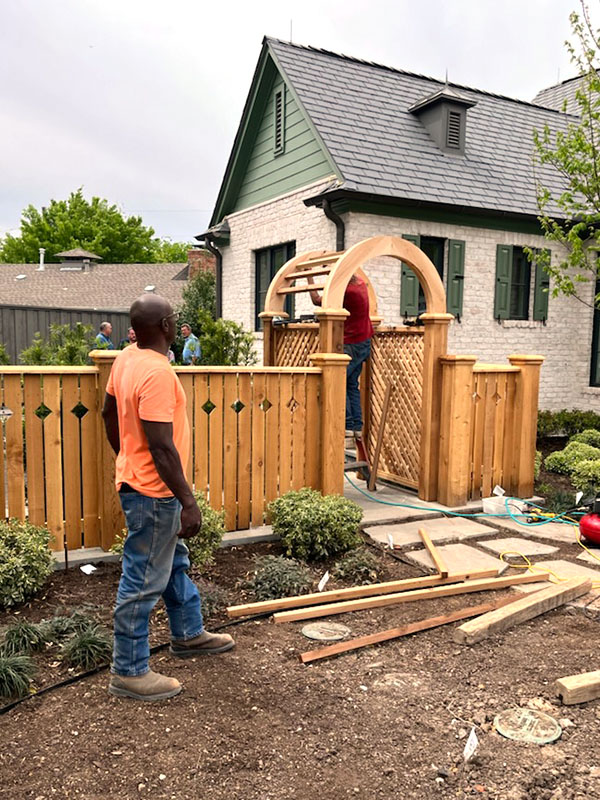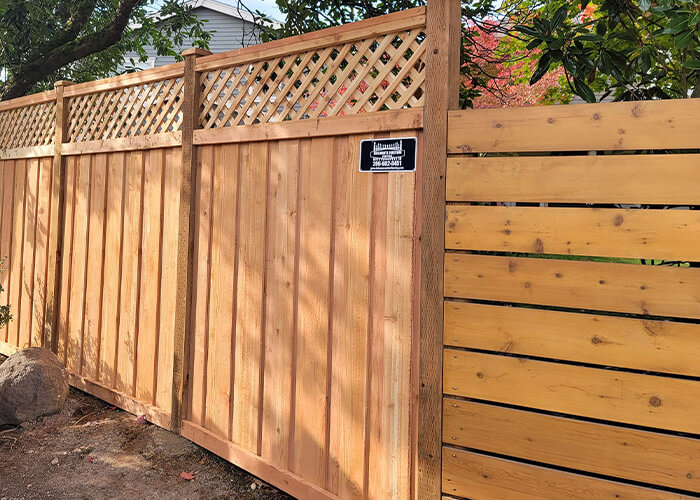Advice for Choosing a Qualified Fence Contractor Near Me
Advice for Choosing a Qualified Fence Contractor Near Me
Blog Article
Exactly How to Identify Usual Problems That Call For Immediate Fence Fixing
It is critical to find issues before they come to be bigger issues when it comes to maintaining your fencing. On a regular basis checking for indicators of rotting timber, leaning panels, or rust can save you time and money in the future. You may not recognize exactly how weather and parasites can jeopardize your fencing's stability. Allow's explore the typical indicators that suggest your fencing requires prompt focus, so you can maintain your home secure and looking its ideal.
Signs of Rotting Wood in Wooden Fences
Have you seen your wood fence looking a little bit even worse for wear? If so, it could be time to look for signs of deteriorating wood. Check out the base of the posts and panels for soft areas. If you push on the wood and it feels mushy or collapses, that's a clear indication of rot. Next, try to find staining or dark areas on the timber-- these often signal moisture damages. Take notice of any peeling off paint or surface, as this can reveal the wood to additional decay. Additionally, a poignant, musty scent can indicate fungal growth. Do not forget to check joints and connections; if they hang or falling apart, the wood beneath is likely compromised. By capturing these indications early, you can avoid extra extensive damage and maintain your fencing standing solid. Routine maintenance is crucial to expanding the life of your wood fence.
Leaning or Tilting Fencing Panels
If you have actually observed your fencing panels turning or leaning, it's important to understand what created it. This concern could suggest underlying structural damages that requires your focus. Allow's check out the usual causes and the repair alternatives readily available to obtain your fencing back in shape.

Root Causes Of Leaning Panels
It's frequently an indicator of underlying problems that require resolving when you discover your fence panels leaning or turning. One usual cause is poor drainage; extreme water can wear down the dirt around the fencing messages, damaging their support. Another culprit might be strong winds or tornados that press versus the panels, especially if they're not effectively secured. Additionally, the all-natural settling of soil with time can create posts to shift, bring about a tilt. Parasites, like termites, can endanger the honesty of wood panels, creating them to lean as well. Inadequate setup methods may result in panels not being securely established, leaving them at risk to leaning under stress. Address these issues immediately to keep your fencing's honesty.
Indicators of Structural Damages
Discovering tilting or leaning fencing panels can be startling, as these concerns usually indicate structural damages that requires instant attention. When your fencing starts to lean, it may indicate that the articles are shifting or that the soil around them has actually deteriorated. Pay close interest to gaps between panels or blog posts, as these can additionally suggest instability. deck builder. Furthermore, check for splits or splintering in the timber, which can damage the overall structure. If you discover corrosion or rust on metal elements, it might jeopardize the honesty of the fencing. Keep in mind, ignoring these signs can lead to much more serious damage down the line, so it's important to evaluate the scenario immediately and act prior to it worsens
Repair Work Options Available

Corrosion and Corrosion in Steel Fences
If you have a steel fence, you could discover corrosion and rust sneaking in in time, specifically if it's revealed to moisture. These problems not only affect the appearance of your fence but can additionally jeopardize its architectural honesty. To recognize corrosion, look for reddish-brown places or spots, which show the metal is oxidizing. Rust can spread swiftly if left unattended, leading and deteriorating the fencing to costly repairs.To take on corrosion and deterioration, you need to clean up the affected areas with a wire brush and use a rust-inhibiting guide. As soon as the guide dries, think about repainting the fence with a weather-resistant paint to safeguard it further. Routine maintenance, such as inspecting for indications of corrosion and touching up paint as required, will certainly aid extend your fencing's life-span. Dealing with these concerns promptly ensures your steel fence stays solid and aesthetically appealing for years to find.
Fractures and Splits in Plastic Fence

Sources Of Plastic Damage
Vinyl fencing is prominent for its toughness, yet it can still deal with cracks and divides because of different variables. One significant cause is severe temperature changes. It can weaken the material over time when plastic expands in the heat and agreements in the cool. Additionally, exposure to harsh sunlight can lead to UV destruction, making the plastic breakable. Physical effects, like unexpected crashes or heavy branches, can likewise create cracks. Poor setup or view utilizing low-quality materials can intensify these concerns. Age plays a role; older plastic fence is more prone to damage. Routine assessments can help you identify these aspects prior to they cause considerable issues. Take aggressive procedures to assure your fencing continues to be strong and intact.
Fixing Cracks Properly
Cracks and divides in your plastic secure fencing can be concerning, addressing them immediately can stop additional damages and maintain the fencing's look. Assess the dimension of the fracture. For little fractures, a vinyl repair service set often includes glue that can bond the sides, offering a smooth fix. Tidy the area extensively before applying the sticky, guaranteeing it adheres effectively. For larger divides, you may require to use a plastic spot. Cut the patch original site to size, use adhesive around the edges, and press it strongly onto the split. Permit it to cure as per the maker's directions. Routine maintenance and quick fixings can expand your fence's life-span, maintaining it looking excellent for several years to come.
Loose or Missing Out On Fence Articles
Loose or absent fencing posts can weaken the stability of your entire fencing structure. If you discover any posts leaning or tottering, it's vital to resolve the concern instantly. Inspect for any indicators of motion, here are the findings as this can cause additional damage in time. You can easily analyze the issue by giving each post a gentle shake-- if it feels unsteady, it's time to take action.For missing out on blog posts, you'll need to replace them asap to maintain your fencing's stability. When you mount new messages, see to it they're securely anchored in the ground with concrete or crushed rock for included security. If a post hangs, tighten it by including added support or driving it deeper into the ground.Ignoring these problems can lead to bigger issues, like voids in your fencing and even total collapse. So, watch on your posts and remain proactive about repair services!
Damage From Climate and Natural Components
Weather and natural environments can ruin your fencing, leading to various kinds of damage that need prompt focus. Hefty rain can create wood to rot, making it weak and unpredictable. Snow accumulation may flex or break panels, while strong winds can uproot fencing articles or trigger areas to lean.If you notice fractures or splintering in wood fences, it suggests drying out because of intense sun direct exposure. Steel fencings can corrosion if protective finishes use off, especially in damp or coastal areas.Inspect your fence regularly after tornados or severe weather condition to catch any damage early. Addressing these concerns promptly can conserve you from pricey repair work down the line. Do not wait until a tiny issue develops into a significant one; remain proactive and keep your fencing in top form to maintain both capability and aesthetic appeal.
Bug Problem and Termite Damage
It's crucial to act promptly to protect against additional destruction when you discover signs of parasite problem or termite damages. Try to find mud tubes along your fencing or hollow-sounding wood, as these suggest termites are at work. You might likewise see tiny holes or frass, which is termite droppings resembling sawdust. If you detect any one of these indicators, it's time to assess the damage.Don' t delay till it's far too late; bugs can endanger your fence's integrity. Check the surrounding area for beetles or ants, as they may be adding to the issue. If you presume an infestation, consider calling a parasite control professional to treat the issue.repairing and confirm or replacing affected areas of your fence immediately not just recovers its strength yet likewise protects against parasites from spreading out further. Remain vigilant to keep your property safe and pest-free.
Frequently Asked Questions
How Commonly Should I Inspect My Fence for Damage?
You should check your fence a minimum of twice a year, preferably during springtime and fall. Regular checks assist you detect damages early, conserving you money and time on repairs while keeping your residential or commercial property's look and security.
Can I Repair a Fence Myself or Hire an Expert?
You can most definitely fix a fencing yourself if you have the right tools and skills. Nonetheless, employing an expert guarantees high quality work and saves you time, especially for complex repairs or substantial damages.
What Equipment Are Needed for Fundamental Fence Repair Services?
For basic fencing fixings, you'll need tools like a hammer, screwdriver, pliers, a saw, a level, and measuring tape. deck builder. Depending on the fixing, you may likewise require nails, screws, or substitute boards
Just How Much Does Fence Repair Service Normally Expense?
Fence repair work costs vary widely, yet you can expect to pay in between $200 and $1,500 relying on products, labor, and extent of damages. It's clever to get numerous quotes for the very best offer.
When Is the very best Time of Year for Fencing Fixes?
The very best time for fencing fixings is throughout moderate weather, generally in spring or early loss. You'll avoid extreme temperatures, making it simpler to work and ensuring the products set appropriately for lasting sturdiness (deck builder). Observing leaning or turning fencing panels can be startling, as these problems often indicate architectural damage that needs prompt attention. Loose or missing fencing posts can undermine the stability of your entire fencing structure. Snow build-up could bend or break panels, while strong winds can uproot fencing messages or trigger sections to lean.If you observe cracks or splintering in wooden fences, it's an indication of drying out due to extreme sun direct exposure. Metal fences can rust if protective layers put on off, specifically in damp or coastal areas.Inspect your fence routinely after tornados or extreme weather to catch any type of damages early. Fence repair costs vary commonly, however you can expect to pay between $200 and $1,500 depending on products, labor, and level of damage
Report this page